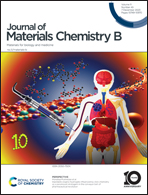A pH-responsive supramolecular hydrogel encapsulating a CuMnS nanoenzyme catalyst for synergistic photothermal–photodynamic–chemodynamic therapy of tumours†
Abstract
Traditional cancer therapies no longer meet the current demand for cancer precision therapy and personalized treatment and it's essential to develop new therapeutic modalities as well as to investigate new combination anti-tumor mechanisms. Therefore, amphiphilic prodrug polymer chains linking methoxy poly(ethylene glycol) (mPEG) and cinnamaldehyde (CA) with adipic acid dihydrazide (ADH) as the pH-responsive center were designed and synthesized, which could self-assemble into PAC micelles in aqueous solution. A supramolecular hydrogel was formed based on the host–guest interaction between α-cyclodextrin (α-CD) and PAC micelles. Polyetherimide (PEI) modified copper manganese sulfide nanoenzyme catalysts (PCMS NPs) were prepared by a solvothermal method, which could be uniformly dispersed in the hydrogel to form a composite supramolecular hydrogel (PCMS@PAC/α-CD Gel). Under an acidic tumor environment, pH-responsive hydrazone bonds were broken, resulting in the slow release of CA and the amplification of hydrogen peroxide (H2O2) levels. PCMS NPs exerted peroxidase (POD)-like activity and catalase (CAT)-like activity, which could convert H2O2 into hydroxyl radicals (˙OH) and oxygen (O2) to alleviate intra-tumor hypoxia and induce apoptosis, while exerting glutathione oxidase (GPX)-like activity to consume glutathione (GSH) to further enhance the effect of chemodynamic therapy (CDT). Under near-infrared light (NIR) irradiation, PCMS NPs exhibited an excellent photothermal conversion performance, which could rapidly increase the temperature of tumor cells to above 42 °C for photothermal therapy (PTT) and convert O2 to a superoxide anion (˙O2−) by exerting oxidase (OXD)-like activity for photodynamic therapy (PDT). It was demonstrated by in vitro and in vivo experiments that the PCMS@PAC/α-CD Gel was highly cytotoxic to cancer cells and could effectively inhibit tumor growth, indicating the potential for applications in the fields of biomedicine and smart materials.

- This article is part of the themed collection: Nanozymes


 Please wait while we load your content...
Please wait while we load your content...